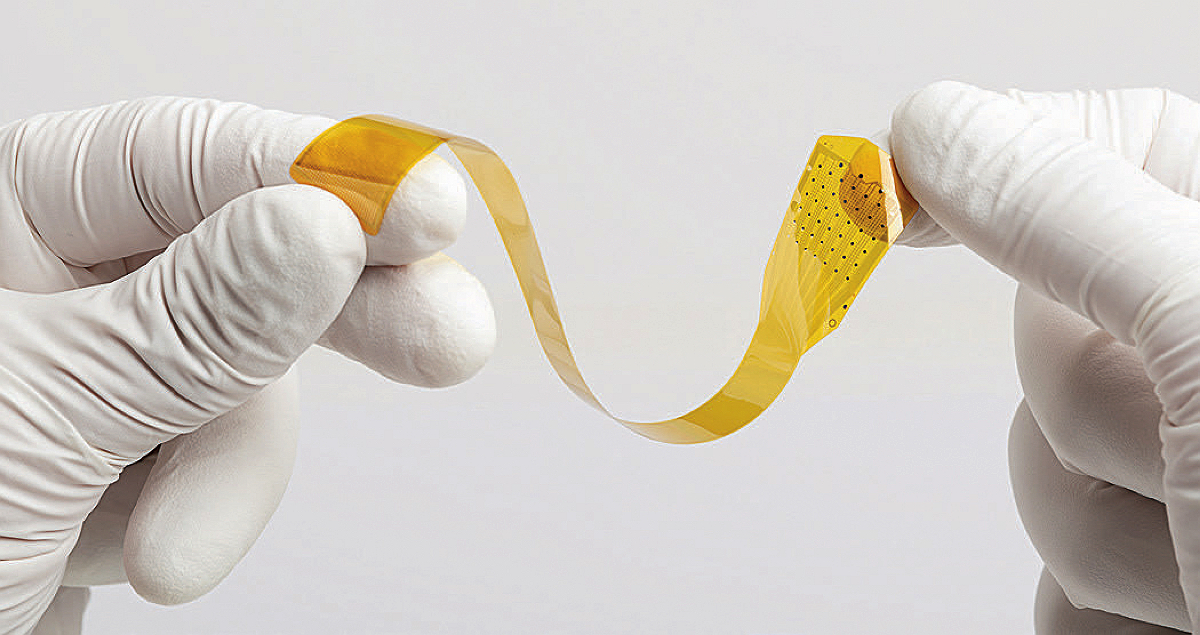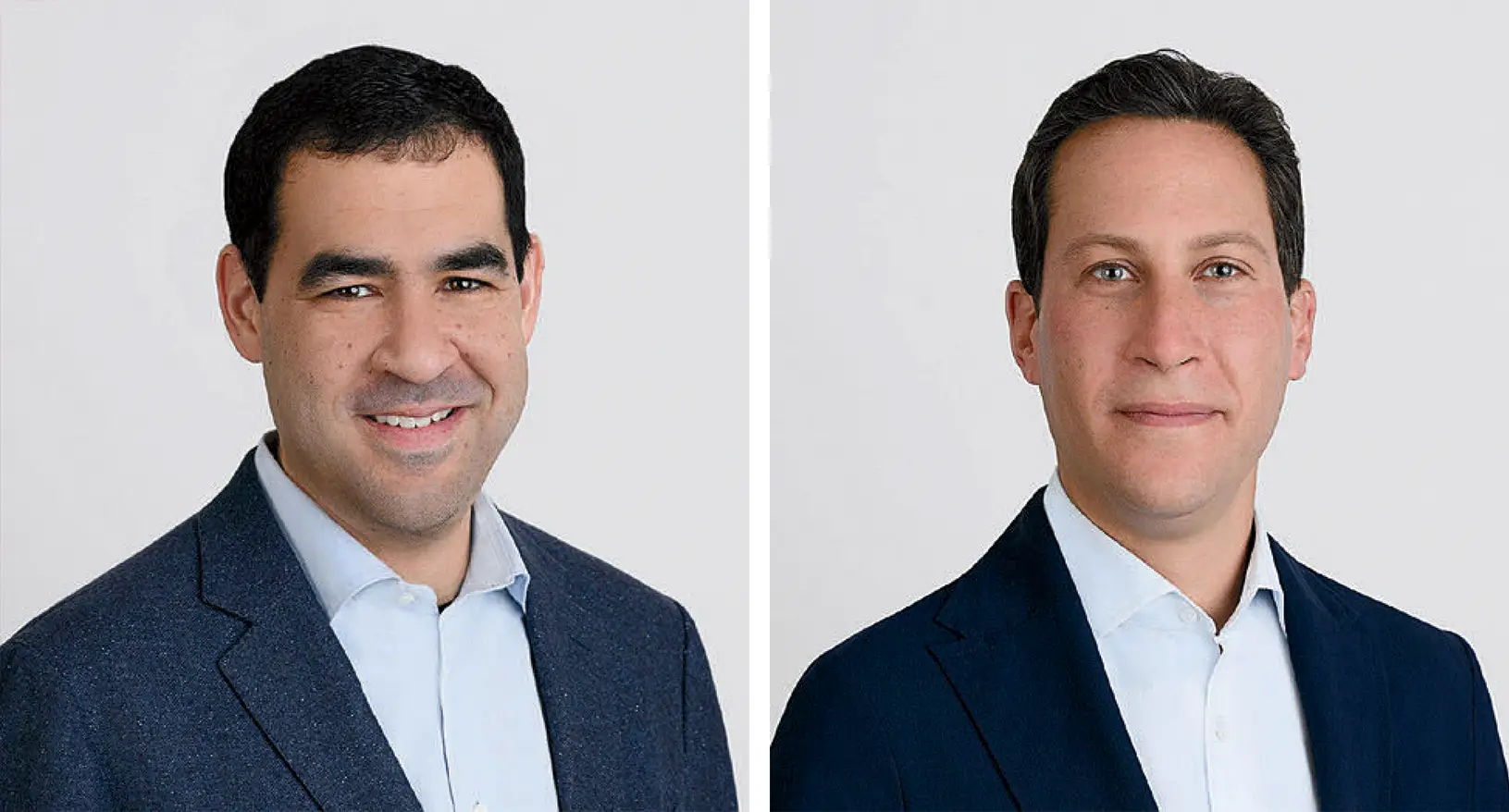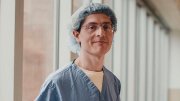Growing up in New York City, Benjamin Rapoport, A.B.-A.M. ’03, M.D. ’08 (’13), often tagged along on weekend hospital rounds with his neurologist father. Samuel Rapoport was also an electrical engineer and a pioneering electrophysiology specialist who created and applied technology to help patients suffering from a range of conditions. He taught his young son about the brain as an electrical system—and how to use evoked potential tests, which involved placing electrodes on the scalp that enabled clinicians to trace the “whole signal transduction chain from the body’s sensory system all the way to the brain,” Rapoport says. “I remember sitting down with my father and doing it with him.”
Some 40 years later, Rapoport, a neurosurgeon at Mount Sinai Hospital in Manhattan with his own doctorate in electrical engineering and computer science from MIT, has developed a microelectrode device that’s implanted directly on the brain. It renders the highest resolution of real-time imaging available, he says, and is poised to revolutionize not only neurological diagnostics, but treatment: giving paralyzed patients the capacity to communicate easily via computerized translations of their thoughts.
Rapoport developed the Layer 7 Cortical Interface at Precision Neuroscience, the New York City-based company he cofounded in 2020 with businessman Michael Mager ’05. So far, the device has been implanted in 27 patients from three health systems (West Virginia University, Penn Medicine, and Mount Sinai), and the company’s application to sell and more extensively use the device is pending clearance from the Food and Drug Administration (FDA).
Precision Neuroscience is among several start-ups—including Synchron, Blackrock Neurotech, BrainGate, and Elon Musk’s Neuralink (of which Rapoport was a cofounder)—racing to create various types of brain-computer interface (BCI) technology. These systems decode and translate the neural signals in a human brain into commands operable through external computerized/roboticized devices. During the past four years, Rapoport and Mager have raised $150 million, added 68 employees, and bought a Texas manufacturing facility for their product—which resembles, deceptively, a plastic yellow bandage. The array is “a super-thin film, one-fifth the thickness of an eyelash,” Mager says, “on which we deposit 1,024 microelectrodes made of platinum, and those are about 50 microns in diameter, so, like, the size of a neuron.”

The film, designed to be applied and removed by neurosurgeons without damaging tissue, is slipped into a slit cut into the skull and applied to the gelatinous brain surface. It was first tested on a human being in April 2023 at a West Virginia hospital, as part of a pilot clinical study to record and map brain activity that was conducted in partnership with West Virginia University’s Rockefeller Neuroscience Institute. Medical staff could immediately see the electrodes transfer information that was rendered on-screen in high-definition color-coded video imaging. “The reds and oranges, the warm colors, are high voltages; the blues and purples are low voltages; and these are traveling waves of activities that move across the brain as you think,” Rapoport explains. “So, it was this movie of the brain thinking in real time. No one had ever seen it working at such a fine scale before. And to see that happening instantaneously was incredibly exciting.”
The goal is to create the array in a wireless form that can translate brain activity via a computer and artificial intelligence to “enable paralyzed people to have thought-based control of a digital interface, so people who can’t move their hands, for example, but who are sound of mind, like a patient with a spinal cord injury or certain forms of stroke, can potentially go back to work,” Rapoport says. Moreover, they could express themselves artistically, communicate with loved ones and, in general, participate more fully in the world. Mager points to the “hundreds of millions of people globally” suffering from neurological illnesses who either lack therapies or whose treatments carry significant side effects. “A technology that has the potential to address some of these conditions,” he says, “is something that animates Ben—and animates all of us at Precision.” The pending FDA clearance would also mean increasing the length of time the devices can remain implanted (from hours to days or weeks), along with the number of patients tested (from dozens to thousands)—enabling Precision to gather far more data on the use of the device as well as on overall brain functionality.
After eight years in Hong Kong as a partner in a hedge fund, Mager returned to the United States wanting to be more integral to building businesses. He and Adam Jiwan ’01 founded a company that bought firms led by older, retiring owners lacking a succession plan, injecting them “with new energy, thinking, and capital to help them grow,” Mager says. “In some cases, a lot.”
In 2015, through their mutual friend Ryan Pakter ’04, M.B.A. ’13, Mager and Rapoport met to discuss developing a business to commercialize BCIs. “The idea he had had the potential to be an enormous, and enormously positively impactful, business,” he says. “Part of Ben’s genius is to design a system that is both high-bandwidth and safe, non-damaging to the brain—and reversible.”
Rapoport first clarified his trajectory at Harvard, while completing his bachelor’s and master’s in physics. Spurred by what he’d seen of his father’s work and his own developing passions, he asked himself, “What’s the most interesting thing in the world?” And answered, “It has to be applied brain science and making that have an impact for real people in the real world.” He went on to earn a master’s at Oxford, studying applied math and neural networks. From there he entered Harvard Medical School, took a break to focus on his MIT doctorate in electrical engineering (completed in 2011), and then finished his medical degree two years later. Along the way, he filed about 10 patents (including graduate work-related filings for micropower electronics for implanted BCIs). He also ventured into entrepreneurship, partnering with a classmate from the Harvard/MIT MD-PhD Program, Craig Mermel, M.D. ’08, Ph.D. ’10, to found Simbionics, which developed health software for wearable technology and was acquired by Apple in 2014. (Mermel subsequently helped develop the Apple watch, then joined Google to lead its digital-pathology business, and is now Precision’s chief product officer.)

“My twenties were basically spent training to become a neurosurgeon,” Rapoport says: soaking up research on neuroelectrical technology and BCIs, working on neural decoding and “thinking about how to put that into a minimally invasive form, and how that could be done in a tiny implant.” As a result, he was tapped by Elon Musk to become one of the eight founders of Neuralink in 2016. Rapoport now says that experience was “clarifying.” It confirmed that BCI technology was “ready scientifically” to move from academic study into commercialization in medicine. But Rapoport also valued safety. At Neuralink, he says, there was debate about the optimum way to make that transition to market, and he was convinced at the time, as he still is, that “brain interfaces that don’t damage the brain are critical…and being able, from a surgeon’s perspective, to implant those devices in a way that is minimally traumatic, safe, scalable, and cosmetically acceptable, is also critical….Those were not the prevailing decision philosophies of the first round of applying BCIs, and I include Neuralink in that.” In 2018, Rapoport left Neuralink and ultimately reconnected with Mager to lay the groundwork for Precision Neuroscience. (Several other former Neuralink employees have joined Precision as well.)
In some ways, Rapoport’s sense of boundaries stems from “being born into the field.” A respect for human anatomy learned in childhood has persisted throughout the seismic shifts in neuroscience and the gradual emergence of BCIs during the last four decades. Reifying those vast changes, he describes the 32-channel clinical amplifier system hand-built by his father—a state-of-the-art, desk-sized machine in the late 1970s and early 1980s with “old-fashioned monitors and all those buttons, knobs, and dials, all the discrete electronic parts visible, and paper tape readouts.” Now, “We encapsulate the function of that desk’s worth of electronics in a quarter-sized electronic implant that is wireless and can handle feedback from a thousand electrodes.”
Rapoport and his father continue to bond through discussing Precision’s array, each weighing in with ideas about related innovations. Their combined expertise in the field reflects developments generated by hundreds of people dedicating their working lives to improving BCI. Projecting that legacy forward, Rapoport points out that he often brings his older daughter, age four, to the hospital: “She hears these meetings and sees what I’m working on. On some level this is all normal to her.” Other colleagues with young children, like Mager, also share their work with their families. “And the kids who are in their ’tween or teenage years are not weirded out by this technology at all. They understand it,” Rapoport adds. “And most of them, if you ask, will tell you, ‘I want a brain chip.’”
Ultimately, whatever “we see 40 years from now is going to be built by young minds that assume this stuff we’re doing now is the base scenario, just like I assumed what my dad was doing in 1980 was the base,” he says. “And if they take what we’re doing now for granted? We are going to be in a totally different world.”








